Instructor Planning Guide
Activities
What activities are associated with this chapter?
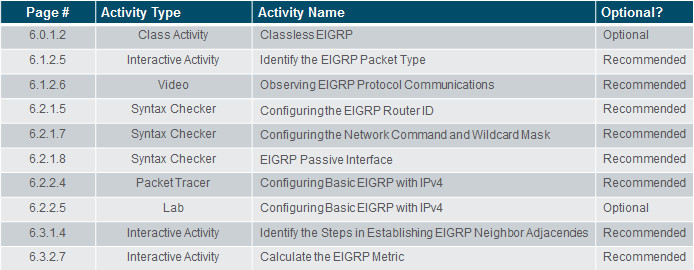

Assessment
Students should complete Chapter 6, “Assessment” after completing Chapter 6.
Quizzes, labs, Packet Tracers and other activities can be used to informally assess student progress.
Sections & Objectives
6.1 EIGRP Characteristics
Explain the features and characteristics of EIGRP.
Describe the basic features of EIGRP.
Describe the types of packets used to establish and maintain an EIGRP neighbor adjacency.
Describe the encapsulation of an EIGRP messages.
6.2 Implement EIGRP for IPv4
Implement EIGRP for IPv4 in a small to medium-sized business network.
Configure EIGRP for IPv4 in a small routed network.
Verify EIGRP for IPv4 operation in a small routed network.
6.3 EIGRP Operation
Explain how EIGRP operates in a small to medium-sized business network.
Explain how EIGRP forms neighbor relationships.
Explain the metrics used by EIGRP.
Explain how DUAL operates and uses the topology table.
Describe events that trigger EIGRP updates.
6.4 Implement EIGRP for IPv6
Implement EIGRP for IPv6 in a small to medium-sized business network.
Compare characteristics and operation of EIGRP for IPv4 to EIGRP for IPv6.
Configure EIGRP for IPv6 in a small routed network.
Verify EIGRP for IPv6 implementation in a small routed network.
Chapter 6: EIGRP
6.1 – EIGRP Characteristics
6.1.1 – EIGRP Basic Features
6.1.1.1 – Features of EIGRP
Enhanced IGRP is a Cisco-proprietary distance-vector routing protocol released in 1992.
- EIGRP was created as a classless version of IGRP.
- Ideal choice for large, multiprotocol networks built primarily on Cisco routers.

6.1.1.2 – Protocol Dependent Modules
EIGRP uses protocol-dependent modules (PDMs) to support different protocols such as IPv4, IPv6, and legacy protocols IPX and AppleTalk.
PDMs are responsible for:
- Maintaining EIGRP neighbor and topology tables
- Computing the metric using DUAL
- Interfacing DUAL and routing table
- Implementing filtering and access lists
- Performing redistribution with other routing protocols
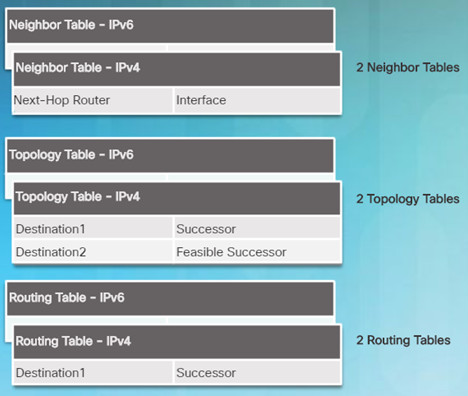
EIGRP maintains individual tables for each routed protocol.
6.1.1.3 – Reliable Transport Protocol
RTP is the EIGRP Transport layer protocol used for the delivery and reception of EIGRP packets.
Not all RTP packets are sent reliably.
- Reliable packets require explicit acknowledgement from destination
- Update, Query, Reply
- Unreliable packets do not require acknowledgement from destination
- Hello, ACK
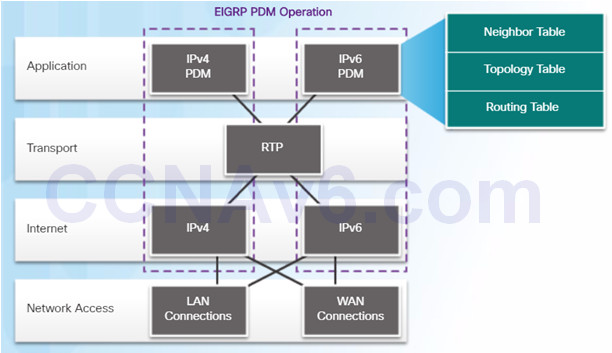
6.1.1.4 – Authentication
EIGRP supports authentication and is recommended.
- EIGRP authentication ensures that routers only accept routing information from other routers that have been configured with the same password or authentication information.
Note:Authentication does not encrypt the EIGRP routing updates.
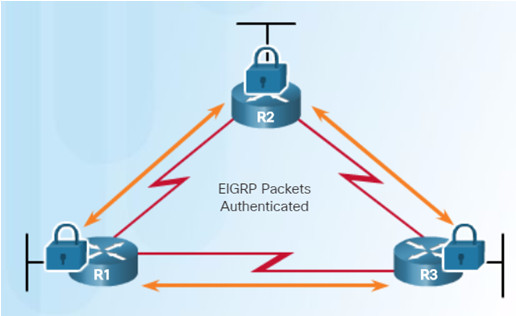
6.1.2 – EIGRP Packet Types
6.1.2.1 – EIGRP Packet Types
IP EIGRP relies on 5 types of packets to maintain its various tables and establish complex relationships with neighbor routers.

6.1.2.2 – EIGRP Hello Packets
Hello packets are used to discover & form adjacencies with neighbors.
- On hearing Hellos, a router creates a neighbor table and the continued receipt of Hellos maintains the table.
Hello packets are always sent unreliably.
- Therefore Hello packets do not require acknowledgment.
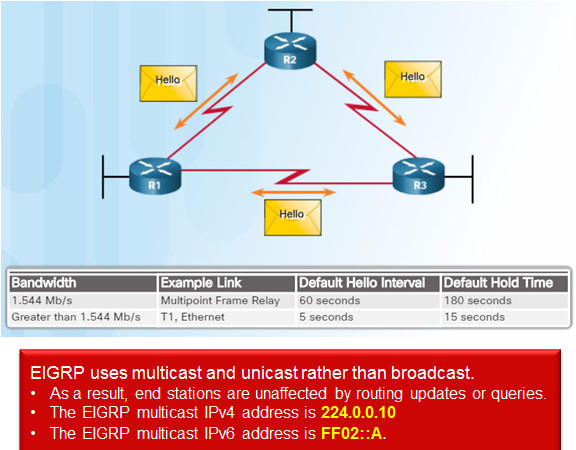
6.1.2.3 – EIGRP Update and Acknowledge Packets
EIGRP Update packets are used to propagate routing information.
- Sent to initially exchange topology information or topology change.
- EIGRP updates only contain needed routing information and are unicast to routers that require it.
- Update packets are sent reliably and therefore requires acknowledgements.
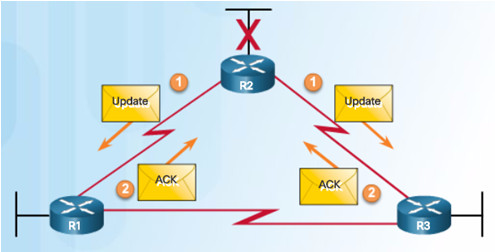
Acknowledgements packets are “dataless” Hello packets used to indicate receipt of any EIGRP packet during a “reliable” (i.e., RTP) exchange.
- Used to acknowledge the receipt of Update packets, Query packets, and Reply packets.
6.1.2.4 – EIGRP Query and Reply Packets
Query and reply packets are used by DUAL when searching for networks.
They both use reliable delivery and therefore require acknowledgement.
Queries can use multicast or unicast, whereas Replies are always sent as unicast.

6.1.2.6 – Video Demonstration – Observing EIGRP Protocol communications
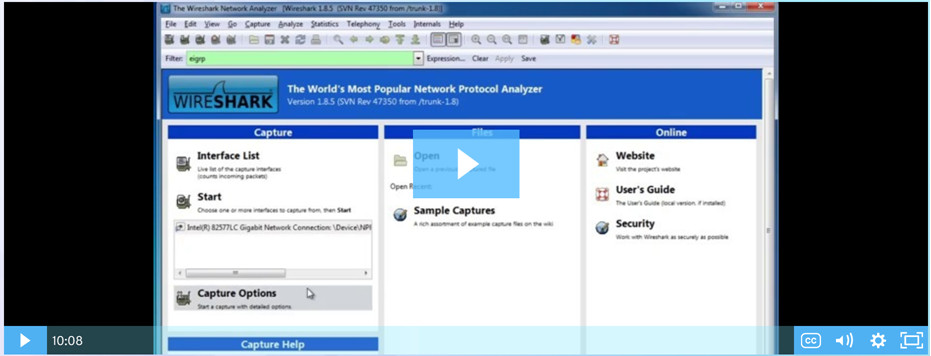
6.1.3 – EIGRP Messages
6.1.3.1 – Encapsulating EIGRP Messages
EIGRP frame contains destination multicast address 01-00-5E-00-00-0A.
The IP packet header contains destination IP address 224.0.0.10 and identifies this packet as an EIGRP packet (protocol 88).
The data portion of the EIGRP message includes:
- Packet header – The EIGRP packet header identifies the type of EIGRP message.
- Type/Length/Value (TLV) – The TLV field contains EIGRP parameters, IP internal and external routes.
EIGRP for IPv6 is encapsulated using an IPv6 header with multicast address FF02::A and the next header field set to protocol 88.
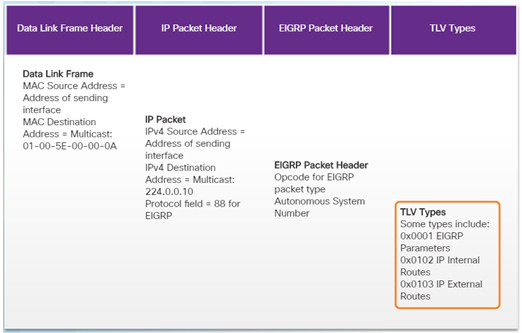
6.1.3.2 – EIGRP Packet Header and TLV
EIGRP messages include the header with an Opcode field that specifies the type of EIGRP packet (Hello, Ack, Update, Query, and Reply) and the AS number field.
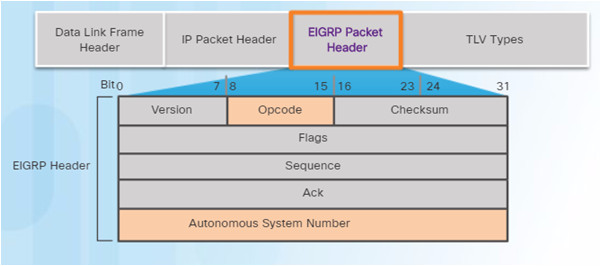
EIGRP TLV: EIGRP Parameters

EIGRP TLV: Internal Routes
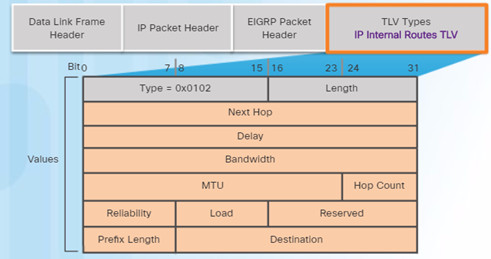
EIGRP TLV: External Routes
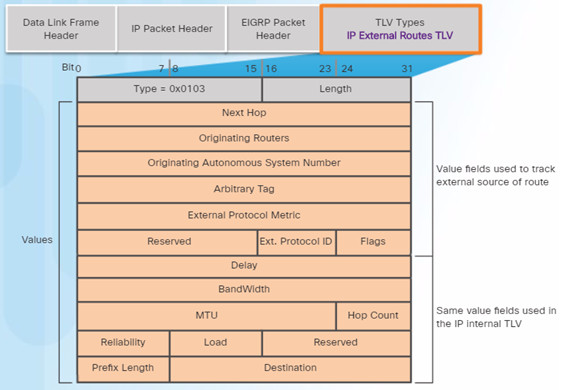
6.2 – Implement EIGRP for IPv4
6.2.1 – Configure EIGRP with IPv4
6.2.1.1 – EIGRP Network Topology
The routers in the topology have a starting configuration that includes addresses on the interfaces. There is currently no static routing or dynamic routing configured on any of the routers.
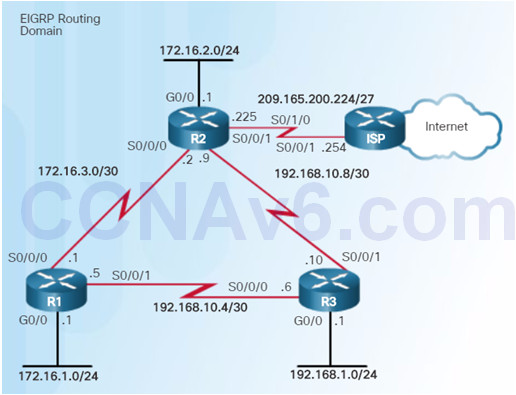
6.2.1.2 – Autonomous System Numbers
An Autonomous System (AS) is a collection of networks under the control of a single authority (reference RFC 1930).
- AS numbers are needed to exchange routes between AS.
- AS numbers are managed by IANA and assigned by RIRs to ISPs, Internet Backbone providers, and institutions connecting to other institutions using AS numbers.
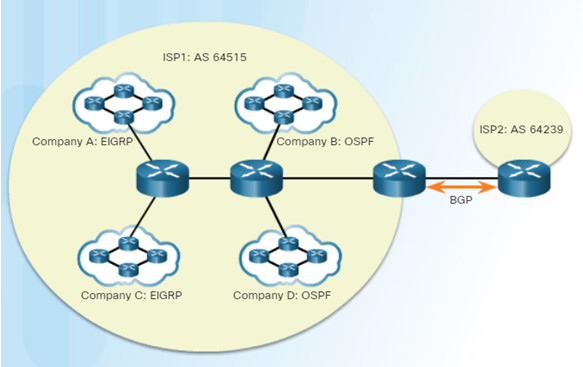
AS numbers are usually 16-bit numbers, ranging from 0 to 65535.
- Since 2007, AS numbers can now be 32 bits, therefore increasing the number of AS numbers to over 4 billion.
6.2.1.3 – The router eigrp Command
To configure EIGRP, use the router eigrp AS-# command.
- The AS-# functions as a process ID.
- The AS number used for EIGRP configuration is only significant to the EIGRP routing domain.
- All routers in the EIGRP routing domain must use the same AS number (process ID number).
Note: Do NOT configure multiple instances of EIGRP on the same router.
6.2.1.4 – EIGRP Router ID
The EIGRP router ID is used to uniquely identify each router in the EIGRP routing domain.
Routers use the following three criteria to determine its router ID:
1.Use the address configured with the eigrp router-id ipv4-address router config command.
2.If the router ID is not configured, choose the highest IPv4 address of any of its loopback interfaces.
3.If no loopback interfaces are configured, choose the highest active IPv4 address of any of its physical interfaces.
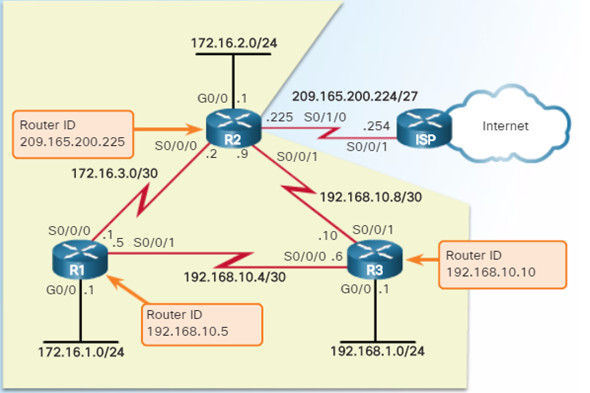
6.2.1.5 – Configuring the EIGRP Router ID
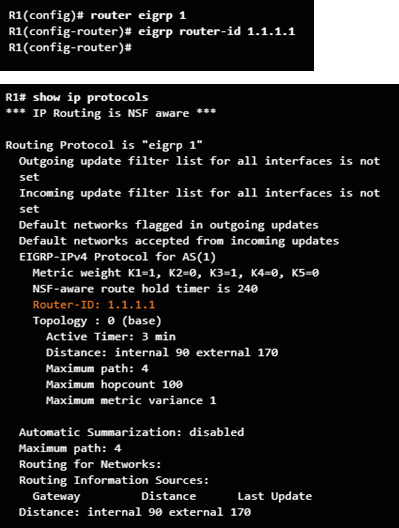
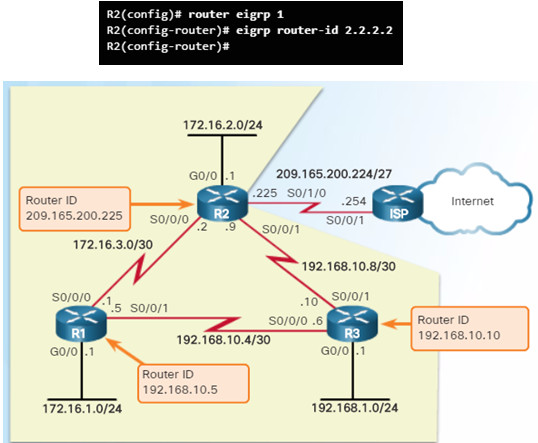
6.2.1.6 –The network Command
Use the network network-number [wildcard-mask] router config command to enable and advertise a network in EIGRP.
- It enables the interfaces configured for that network address to begin transmitting & receiving EIGRP updates
- Includes network or subnet in EIGRP updates
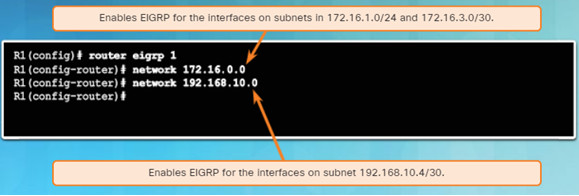
6.2.1.7 –The network Command and Wildcard Mask
A wildcard mask is similar to a subnet mask but is calculated by subtracting a SNM from 255.255.255.255.
For example, if the SNM is 255.255.255.252:
255.255.255.255
– 255.255.255.252
- 0. 0. 3Wildcard mask
EIGRP also automatically converts a subnet mask to its wildcard mask equivalent.
E.g., entering 192.168.10.8 255.255.255.252 automatically converts to 192.168.10.8 0.0.0.3
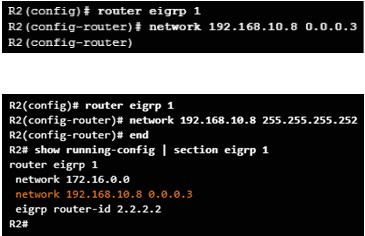
6.2.1.8 –Passive Interface
Passive interfaces prevent EIGRP updates out a specified router interface.

Set a particular interface or all router interfaces to passive.
- The default option sets all router interfaces to passive.
- Prevents neighbor relationships from being established.
- Routing updates from a neighbor are ignored.
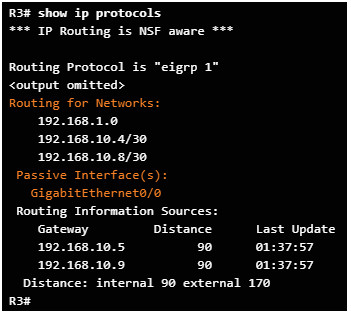
6.2.2 – Verify EIGRP with IPv4
6.2.2.1 –Verifying EIGRP: Examining Neighbors
Use the show ip eigrp neighbors command to view the neighbor table and verify that EIGRP has established an adjacency with its neighbors.
- The output displays a list of each adjacent neighbor.
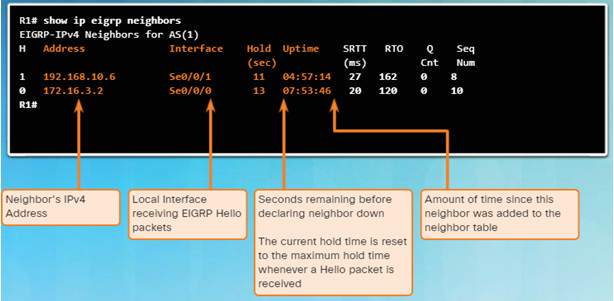
6.2.2.2 –Verifying EIGRP: show ip protocols Command
The show ip protocols command is useful to identify the parameters and other information about the current state of any active IPv4 routing protocol processes configured on the router.
For example, in the command output in the figure:
1.EIGRP is an active dynamic routing protocol on R1 configured with the autonomous system number 1.
2.The EIGRP router ID of R1 is 1.1.1.1.
3.The EIGRP administrative distances on R1 are internal AD of 90 and external of 170 (default values).
4.By default, EIGRP does not automatically summarize networks. Subnets are included in the routing updates.
5.The EIGRP neighbor adjacencies R1 has with other routers used to receive EIGRP routing updates.
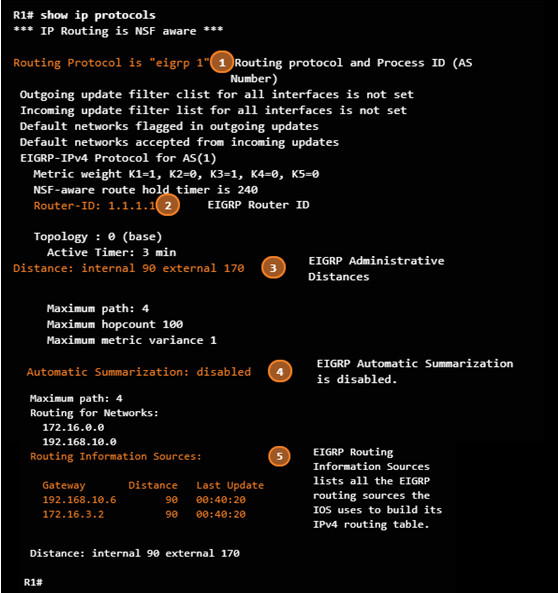
6.2.2.3 –Verifying EIGRP: Examine the IPv4 Routing Table
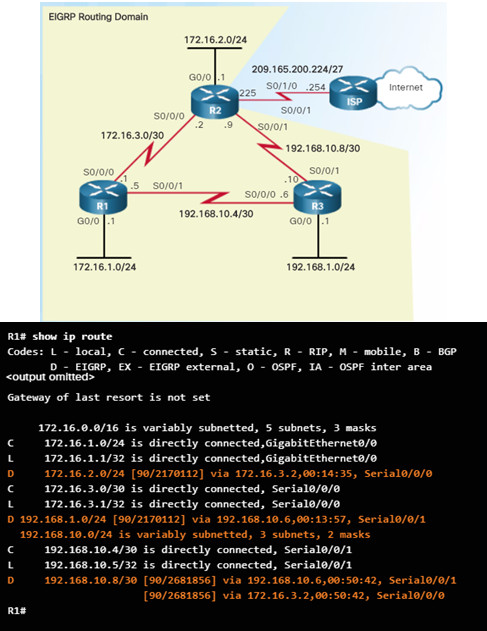

6.2.2.4 –Packet Tracer – Configuring Basic EIGRP with IPv4
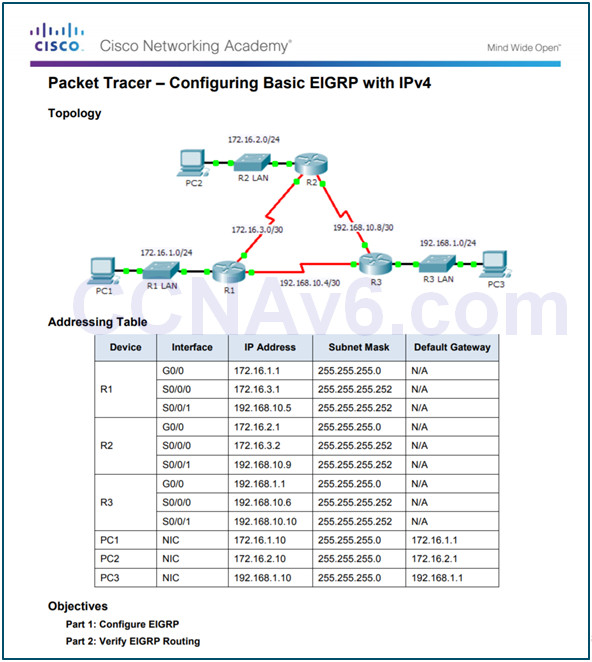
6.2.2.4 Packet Tracer – Configuring Basic EIGRP with IPv4
6.2.2.5 –Lab – Configuring Basic EIGRP with IPv4
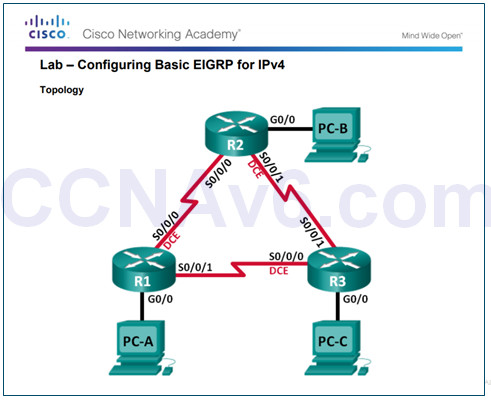
6.2.2.5 Lab – Configuring Basic EIGRP for IPv4
6.3 –EIGRP Operation
6.3.1 – EIGRP Initial Route Discovery
6.3.1.1 – EIGRP Neighbor Adjacency
1.Router R1 starts has joined the EIGRP routing domain and sends an EIGRP Hello packet out all EIGRP enabled interfaces.
2.Router R2 receives the Hello packet and adds R1 to its neighbor table.
- R2 sends an Update packet that contains all the routes it knows.
- R2 also sends an EIGRP Hello packet to R1.
3.R1 updates its neighbor table with R2.
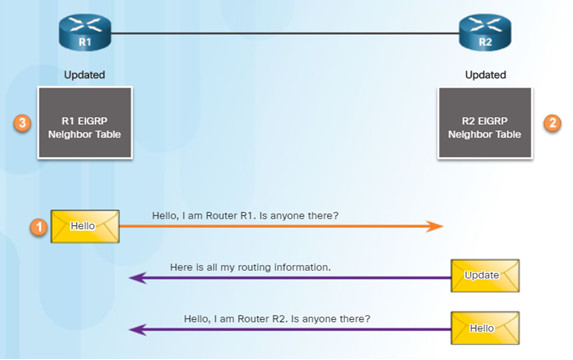
After both routers have exchanged Hellos, the neighbor adjacency is established.
6.3.1.2 – EIGRP Topology Table
1.R1 adds all update entries from R1 to its topology table.
- The topology table includes all destinations advertised by neighboring (adjacent) routers and the cost (metric) to reach each network.
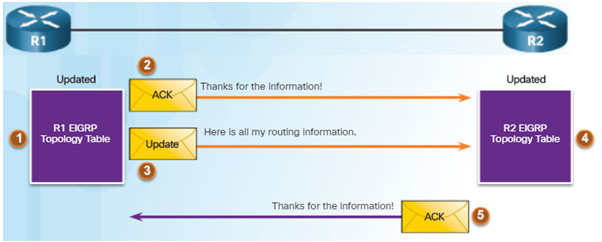
2.EIGRP update packets use reliable delivery; therefore, R1 replies with an EIGRP acknowledgment packet informing R2 that it has received the update.
3.R1 sends an EIGRP update to R2 advertising the routes that it is aware of, except those learned from R2 (split horizon).
4.R2 receives the EIGRP update from R1 and adds this information to its own topology table.
5.R2 responds to R1’s EIGRP update packet with an EIGRP acknowledgment.
6.3.1.3 – EIGRP Convergence
1.R1 uses DUAL to calculate the best routes to each destination, including the metric and the next-hop router and updates its routing table with the best routes.
2.Similarly, R2 uses DUAL and updates its routing table with the best newly discovered routes.
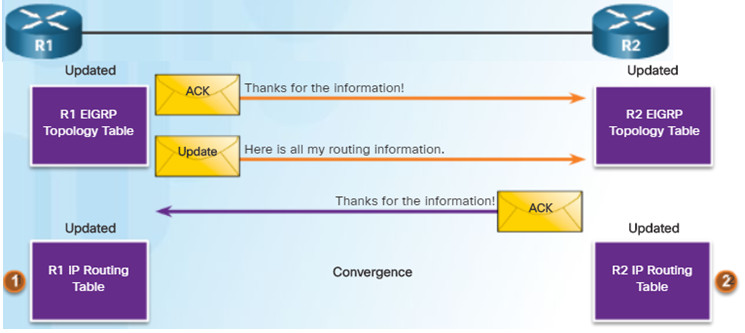
At this point, EIGRP on both routers is considered to be in the converged state.
6.3.2 – EIGRP Metrics
6.3.2.1 – EIGRP Composite Metric
EIGRP uses a composite metric which can be based on the following metrics:
- Bandwidth: The lowest bandwidth between source and destination.
- Delay: The cumulative interface delay along the path
- Reliability: (Optional) Worst reliability between source and destination.
- Load: (Optional) Worst load on a link between source and destination.
The EIGRP composite metric formula consists metric weights with values K1 to K5.
- K1 represents bandwidth, K3 delay, K4 load, and K5 reliability.
Note: It is often incorrectly stated that EIGRP can also use the smallest MTU in the path.

6.3.2.2 – Examining Interface Metric Values
Use the show interfaces command to examine the values used for bandwidth, delay, reliability, and load.
- BW – Bandwidth of the interface (in kb/s).
- DLY – Delay of the interface (in microseconds).
- Reliability – Reliability of the interface as a fraction of 255 (255/255 is 100% reliability).
- Txload, Rxload – Transmit and receive load on the interface as a fraction of 255 (255/255 is completely saturated), calculated as an exponential average over five minutes.
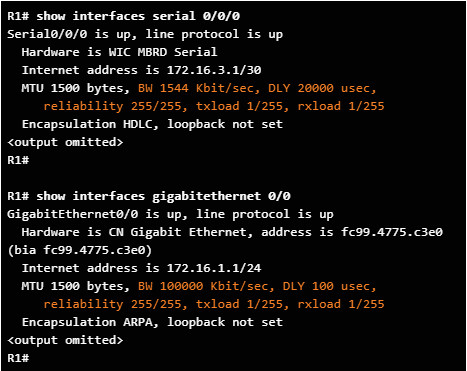
6.3.2.3 – Bandwidth Metric
Use the following interface configuration mode command to modify the bandwidth metric:
- Router(config-if)# bandwidth kilobits-bandwidth-value

Use the show interfaces command to verify the new bandwidth parameters.
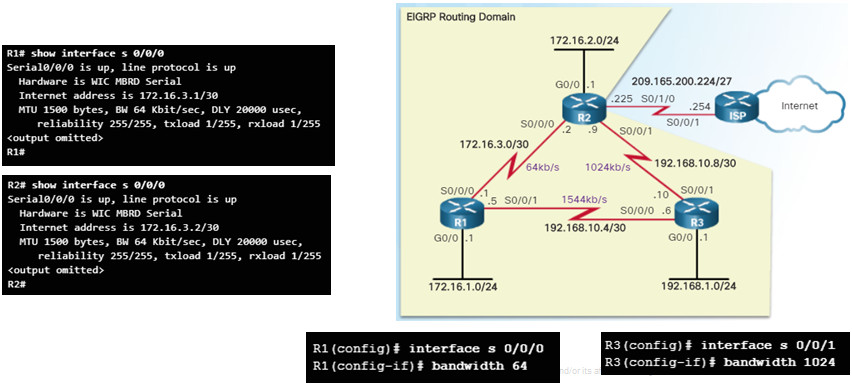
6.3.2.4 – Delay Metric
Delay is a measure of the time it takes for a packet to traverse a route.
The delay (DLY) metric is not measured dynamically.
- It is a static value measured in microseconds (μs or usec) based on the type of link to which the interface is connected.
The delay value is calculated using the cumulative (sum) of all interface delays along the path, divided by 10.
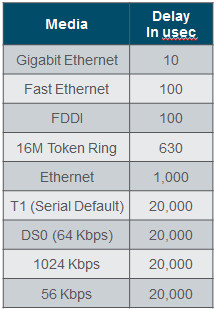
6.3.2.5 – How to Calculate the EIGRP Metric
We can determine the EIGRP metric as follows:
1.Determine the link with the slowest bandwidth and use that value to calculate bandwidth (10,000,000/bandwidth).
2.Determine the delay value for each outgoing interface on the way to the destination and add the delay values and divide by 10 (sum of delay/10).
3.This composite metric produces a 24-bit value which EIGRP multiplies with 256.
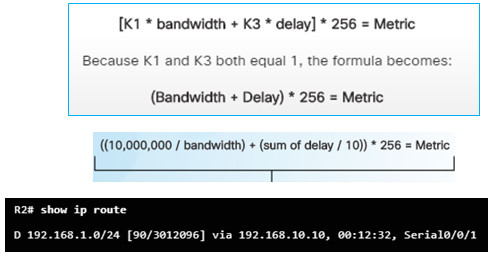
6.3.2.6 – Calculating the EIGRP Metric
How does EIGRP determine the following metric?

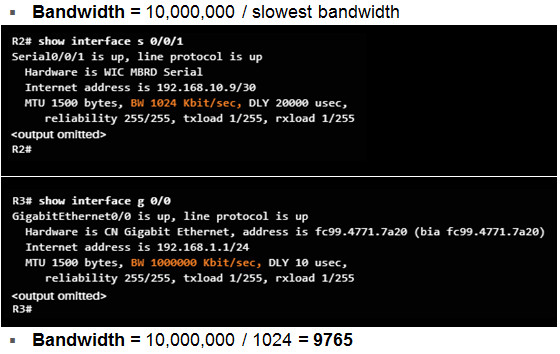
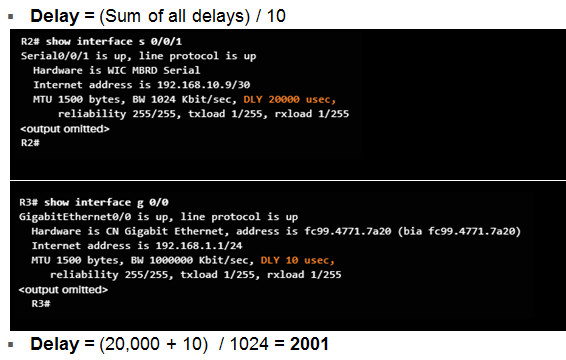
EIGRP Composite Metric = (9765 + 2001) x 256 = 3,012.096
6.3.3 – DUAL and the Topology Table
6.3.3.1 – DUAL Concepts
EIGRP uses the Diffusing Update Algorithm (DUAL) to provide the best and backup loop-free paths.
DUAL uses several terms, which are discussed in more detail throughout this section:

6.3.3.2 – Introduction to DUAL
Routing loops, even temporary ones, can be detrimental to network performance and EIGRP prevents routing loops with the DUAL algorithm.
- The DUAL algorithm is used to obtain loop-freedom at every instance throughout a route computation.
The decision process for all route computations is done by the DUAL Finite State Machine (FSM). An FSM is a workflow model, similar to a flow chart, which is composed of the following:
- A finite number of stages (states)
- Transitions between those stages
- Operations
The DUAL FSM tracks all routes and uses EIGRP metrics to select efficient, loop-free paths, and to identify the routes with the least-cost path to be inserted into the routing table.
6.3.3.3 – Successor and Feasible Distance
A successor is a neighboring router with the least-cost route to the destination network.
- The successor IP address is shown right after “via”.
FD is the lowest calculated metric to reach the destination network.
- FD is the second number inside the brackets.
- Also known as the “metric” for the route.
Notice that EIGRP’s best path for the 192.168.1.0/24 network is through router R3, and that the feasible distance is 3,012,096.
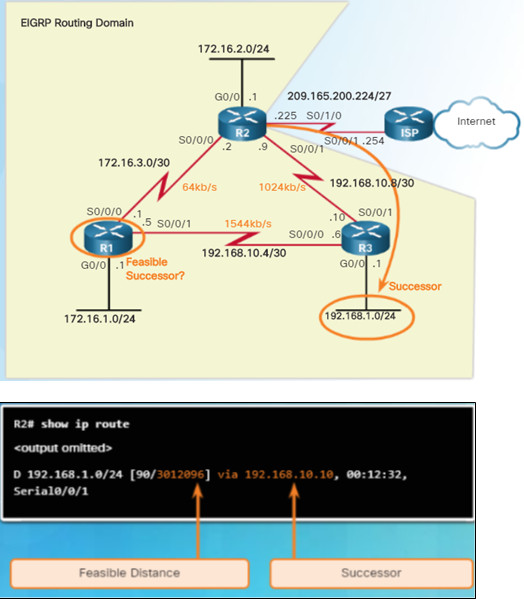
6.3.3.4 – Feasible Successors, Feasibility Condition, and Reported Distance
DUAL converges quickly because it can use backup paths known as Feasible Successors (FSs).
A FS is a neighbor with a loop-free backup path to the same network as the successor.
- A FS must satisfy the Feasibility Condition (FC).
- The FC is met when a neighbor’s Reported Distance (RD) is less than the local router’s feasible distance.
- If the reported distance is less, it represents a loop-free path.
E.g., the RD of R1 (2,170,112) is less than R2’s own FD (3,012,096) and therefore, R1 meets the FC and becomes the FS for R2 to the 192.168.1.0/24 network.
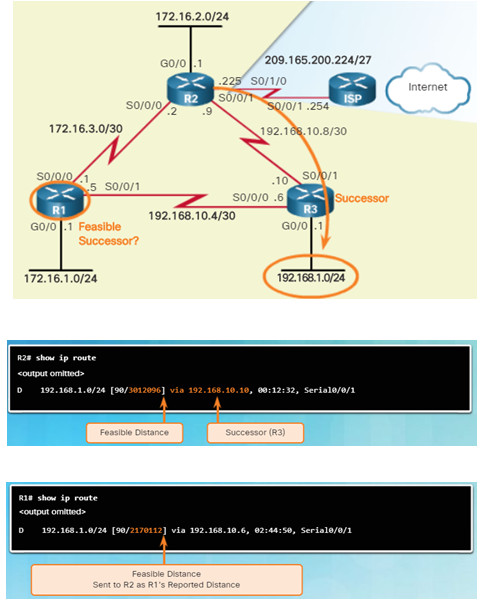
Topology table stores the following information required by DUAL to calculate distances and vectors to destinations.
- The reported distance (RD) that each neighbor advertises for each destination
- The feasible distance (FD) that this router would use to reach the destination via that neighbor.
Use the show ip eigrp topology command to list all successors and FSs to destination networks.
- Only the successor is installed into the IP routing table.
- Passive State – Route is in stable state and available for use.
- Active State – Route is being recomputed by DUAL.
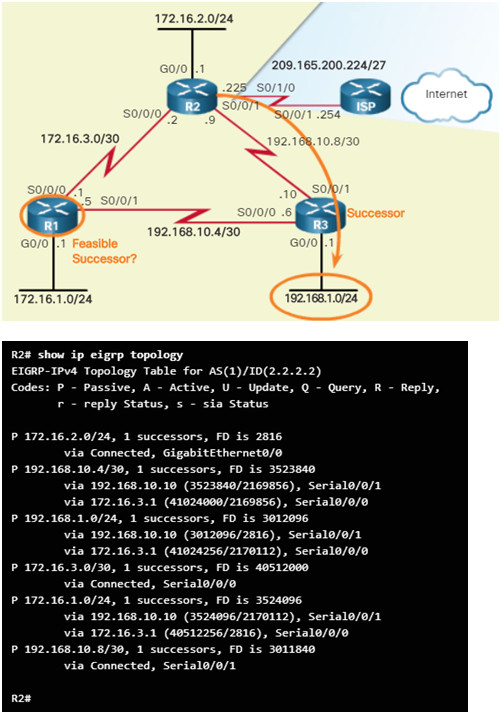
6.3.3.7 – Topology Table: No Feasible Successor
The partial output of the show ip route command displays the 192.168.1.0/24 route with the successor is R3 via 192.168.10.6 with an FD of 2,170,112.
The show ip eigrp topology command only shows the successor 192.168.10.6, which is R3.
- Notice there are no FSs.
The show ip eigrp topology all-links command shows all possible paths to a network, including successors, FSs, and even those routes that are not FSs.

6.3.4 – DUAL and Convergence
6.3.4.1 – DUAL Finite State machine (FSM)
The DUAL Finite State Machine (FSM) contains all of the logic used to calculate and compare routes in an EIGRP network.
An FSM is an abstract machine, that defines a set of possible states that something can go through, what events cause those states, and what events result from those states.
Designers use FSMs to describe how a device, computer program, or routing algorithm reacts to a set of input events.
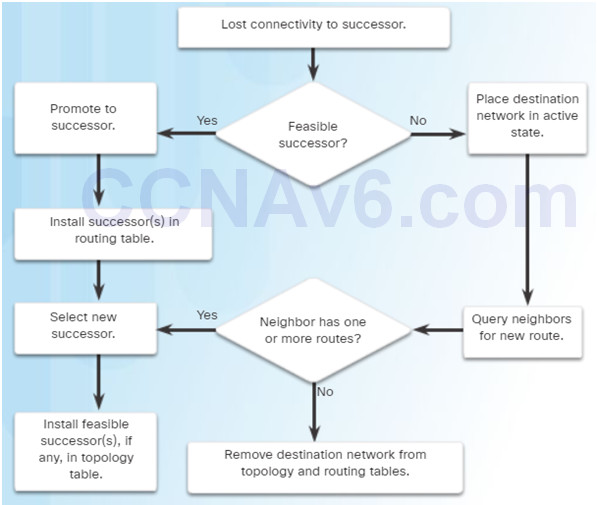
6.3.4.2 – DUAL: Feasible Successor
IP EIGRP
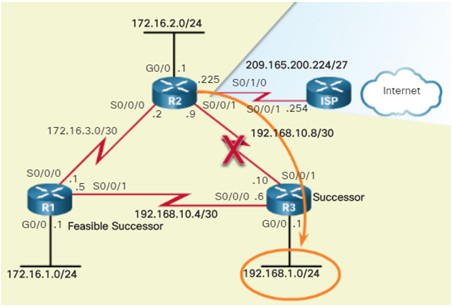
6.3.4.3 – DUAL: No Feasible Successor
If the path to the successor fails and there are no FSs, DUAL puts the network into the active state and actively queries its neighbors for a new successor.
- DUAL sends EIGRP queries asking other routers for a path to the network.
- Other routers return EIGRP replies, letting the sender of the EIGRP query know that they have a path to the requested network. If there is no reply, the sender of the query does not have a route to this network.
- If the sender receives EIGRP replies with a path to the requested network, the preferred path is added as the new successor and also added to the routing table.
6.3.4.4 – Packet Tracer – Investigating DUAL FSM
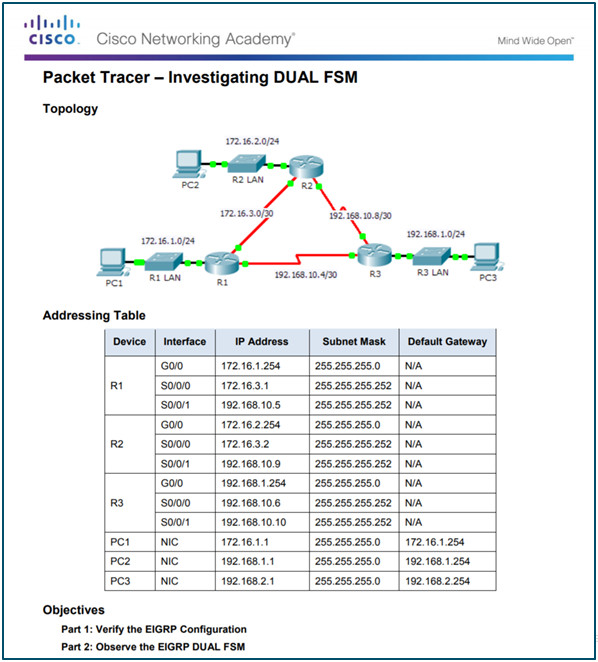
6.3.4.4 Packet Tracer – Investigating DUAL FSM
6.4 –Implement EIGRP for IPv6
6.4.1 – EIGRP for IPv6
6.4.1.1 – EIGRP for IPv6
EIGRP for IPv6 is a distance-vector routing protocol.
- The configuration and operation is similar to EIGRP for IPv4.
The following remained the same as EIGRP for IPv4:
- Uses the same protocol number (88)
- Maintains a topology table and queries if no feasible successors are available.
- Uses DUAL to calculate the successor routes
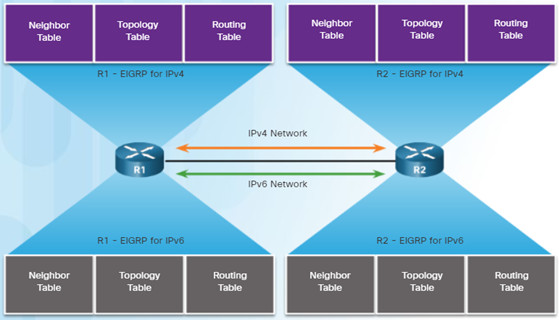
6.4.1.2 – Compare EIGRP for IPv4 and IPv6
- The following compares EIGRP for IPv4 and IPv6
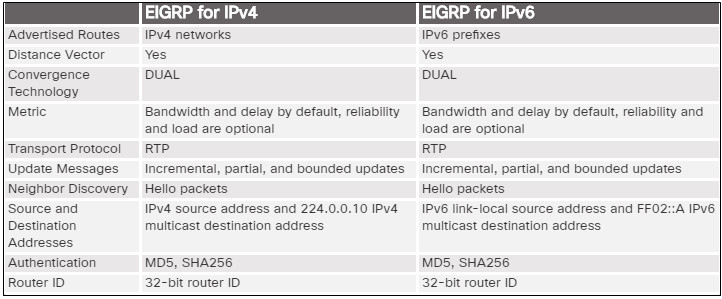
6.4.1.3 – IPv6 Link-local Addresses
EIGRP for IPv6 messages are sent using:
- Source IPv6 address – This is the IPv6 link-local address of the exit interface.
- Destination IPv6 address – When the packet needs to be sent to a multicast address, it is sent to the IPv6 multicast address FF02::A, the all-EIGRP-routers with link-local scope. If the packet can be sent as a unicast address, it is sent to the link-local address of the neighboring router.
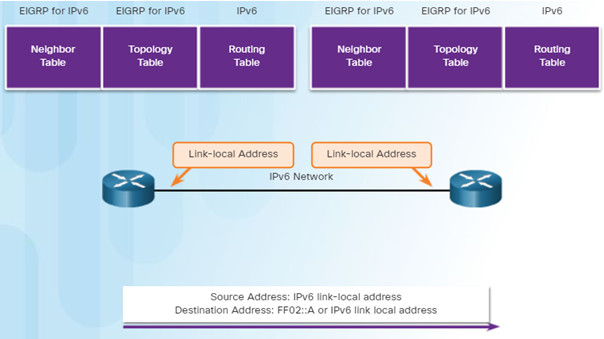
6.4.2 – Configure EIGRP for IPv6
6.4.2.1 – EIGRP for IPv6 Network Topology
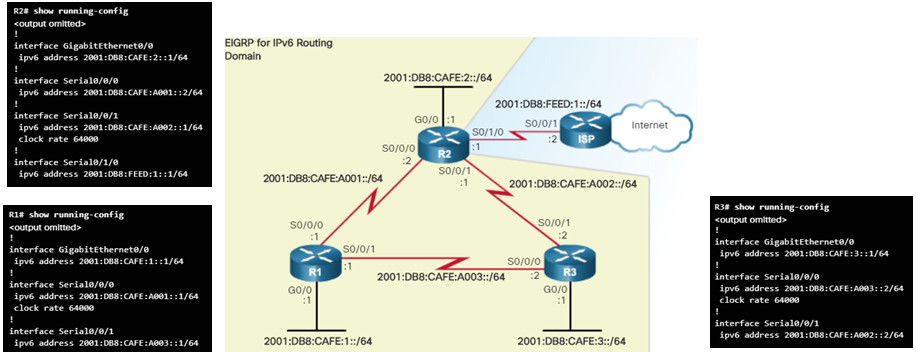
6.4.2.2 – Configuring IPv6 Link-local Addresses
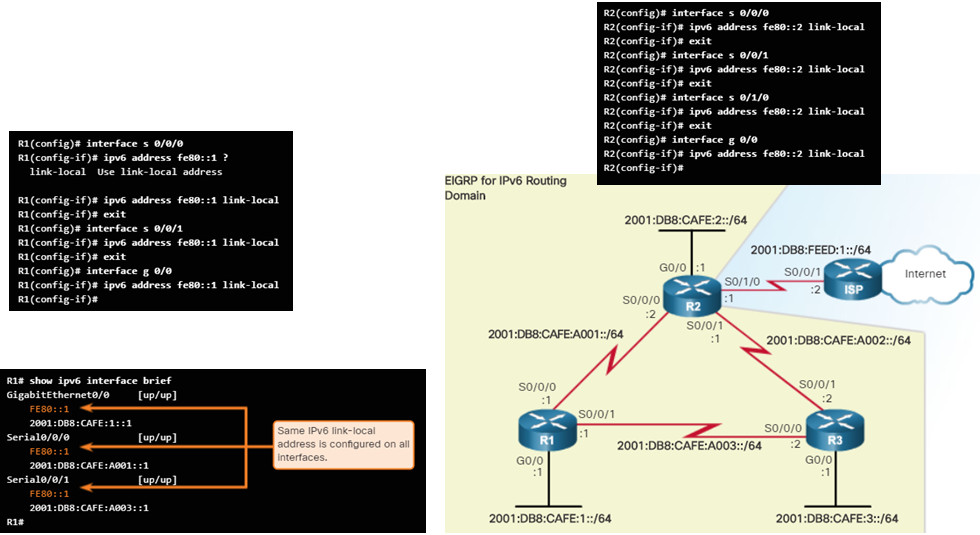
6.4.2.3 – Configuring the EIGRP for IPv6 Routing Process
The ipv6 unicast-routing global config mode command enables IPv6 routing on the router.
Use the ipv6 router eigrp autonomous-system to enter EIGRP for IPv6 router configuration mode.
Use the eigrp router-id router-id command is used to configure the router ID.
By default, the EIGRP for IPv6 process is in a shutdown state and theno shutdown command is required to activate the EIGRP for IPv6 process.
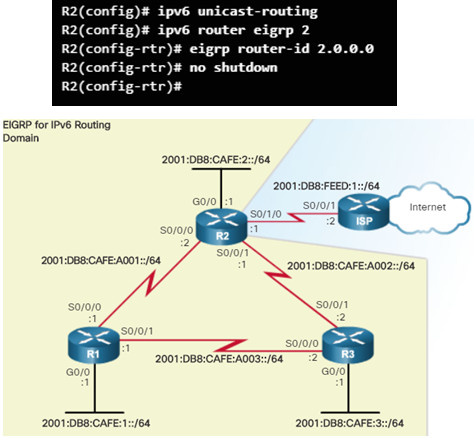
6.4.2.4 – The ipv6 eigrp Interface Command
Unlike EIGRP for IPv4 which uses the network command, EIGRP for IPv6 is configured directly on the interface using the ipv6 eigrp autonomous-system interface configuration command.
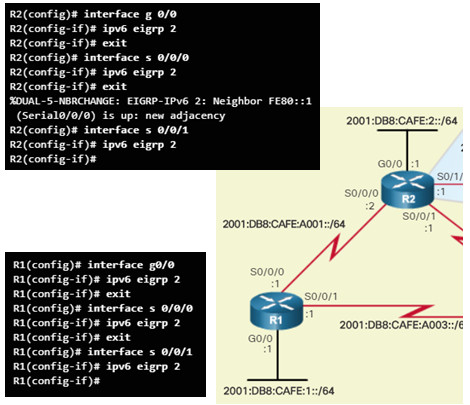
The same passive-interface command used for IPv4 is used with EIGRP for IPv6.
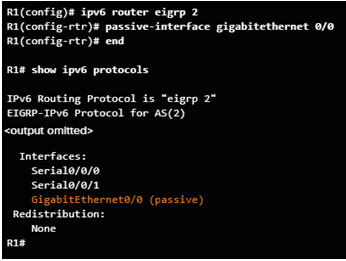
6.4.3 – Verifying EIGRP for IPv6
6.4.3.1 – IPv6 Neighbor Table
Use the show ipv6 eigrp neighbors command to view the neighbor table and verify that EIGRP for IPv6 has established an adjacency with its neighbors.
H – Lists the neighbors in order they were learned.
Address – IPv6 link-local address of the neighbor.
Interface – Local interface that received the Hello.
Hold – Current hold time.
Uptime – Time since this neighbor was added.
SRTT and RTO – Used by RTP.
Queue Count – Should always be zero.
Sequence Number – Used to track updates, queries, and reply packets.
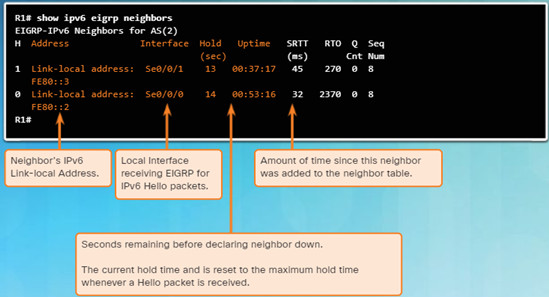
6.4.3.2 – The show ip protocols Command
The show ipv6 protocols command displays the parameters and other information about the state of any active IPv6 routing protocol processes currently configured on the router.
1. EIGRP for IPv6 is an active dynamic routing protocol on R1.
2.These are the k values used to calculate the EIGRP composite metric.
3.The EIGRP for IPv6 router ID of R1 is 1.0.0.0.
4.Same as EIGRP for IPv4, EIGRP for IPv6 administrative distances have internal AD of 90 and external of 170 (default values).
5.The interfaces enabled for EIGRP for IPv6.

6.4.3.3 – The EIGRP for IPv6 Routing Table
Use the show ipv6 route command to examine the IPv6 routing table.
- EIGRP for IPv6 routes are denoted with a D.
The figure shows that R1 has installed three EIGRP routes to remote IPv6 networks in its IPv6 routing table:
- 2001:DB8:CAFE:2::/64 via R3 (FE80::3) using its Serial 0/0/1 interface
- 2001:DB8:CAFE:3::/64 via R3 (FE80::3) using its Serial 0/0/1 interface
- 2001:DB8:CAFE:A002::/64 via R3 (FE80::3) using its Serial 0/0/1 interface

6.4.3.4 – Packet Tracer – Configuring Basic EIGRP with IPv6
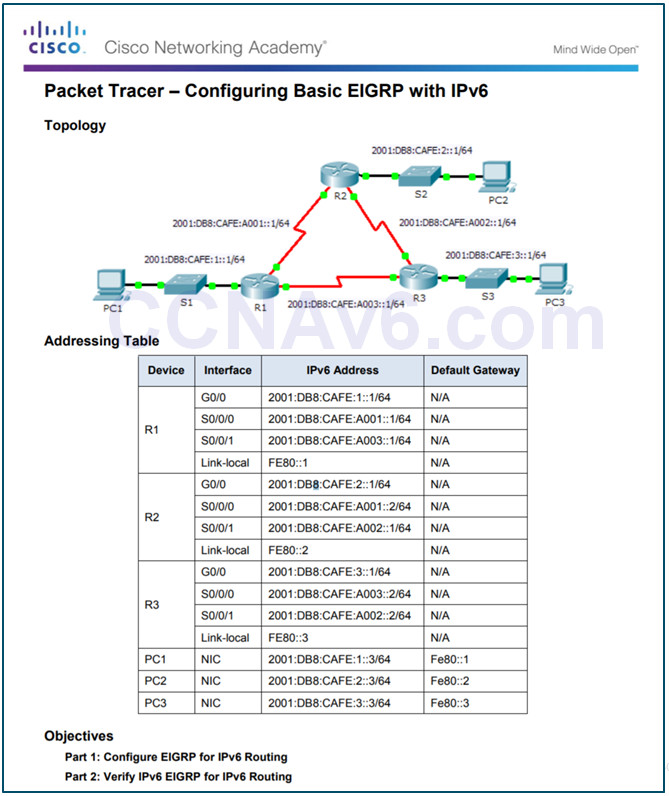
6.4.3.4 Packet Tracer – Configuring Basic EIGRP with IPv6 Routing
6.4.3.5 – Lab – Configuring Basic EIGRP with IPv6
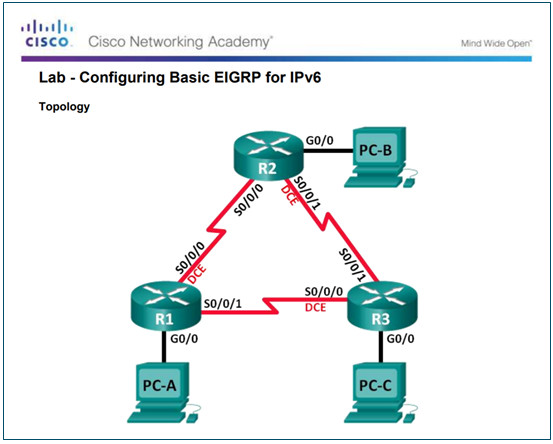
6.4.3.5 Lab – Configuring Basic EIGRP for IPv6
6.5 – Summary
6.5.1 – Conclusion
6.5.1.1 Portfolio RIP and EIGRP Instructions
6.5.1.1 Portfolio RIP and EIGRP Instructions
6.5.1.2 – Packet Tracer – Skills Integration Challenge
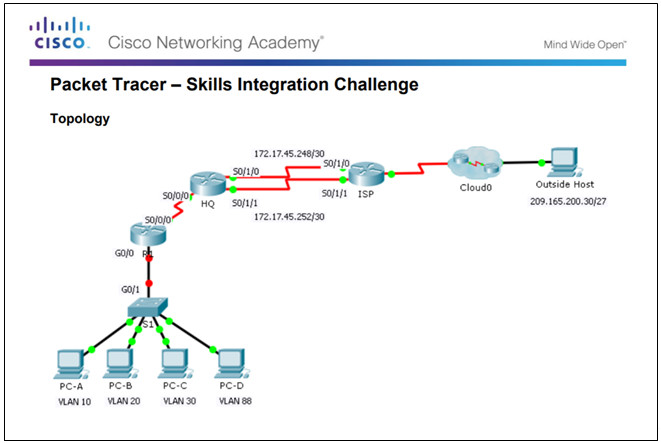
6.5.1.3 – Chapter 6: EIGRP
EIGRP (Enhanced Interior Gateway Routing Protocol) is a classless, distance vector routing protocol.
EIGRP uses the source code of “D” for DUAL in the routing table. EIGRP has a default administrative distance of 90 for internal routes and 170 for routes imported from an external source, such as default routes. These features include: Diffusing Update Algorithm (DUAL), establishing neighbor adjacencies, Reliable Transport Protocol (RTP), partial and bounded updates, and equal and unequal cost load balancing.
EIGRP uses PDMs (Protocol Dependent Modules) giving it the capability to support different Layer 3 protocols including IPv4 and IPv6. EIGRP uses reliable delivery for EIGRP updates, queries and replies; and uses unreliable delivery for EIGRP Hellos and acknowledgments. Reliable RTP means an EIGRP acknowledgment must be returned.
Before any EIGRP updates are sent, a router must first discover its neighbors using EIGRP Hello packets. The Hello and hold-down values do not need to match for two routers to become neighbors. The show ip eigrp neighbors command is used to view the neighbor table and verify that EIGRP has established an adjacency with its neighbors.
EIGRP sends partial or bounded updates, which include only route changes. Updates are sent only to those routers that are affected by the change. EIGRP composite metric uses bandwidth, delay, reliability, and load to determine the best path. By default only bandwidth and delay are used.
At the center of EIGRP is DUAL (Diffusing Update Algorithm). The DUAL Finite State Machine is used to determine best path and potential backup paths to every destination network. The successor is a neighboring router that is used to forward the packet using the least-cost route to the destination network. Feasible distance (FD) is the lowest calculated metric to reach the destination network through the successor. A feasible successor (FS) is a neighbor who has a loop-free backup path to the same network as the successor, and also meets the feasibility condition. The feasibility condition (FC) is met when a neighbor’s reported distance (RD) to a network is less than the local router’s feasible distance to the same destination network. The reported distance is simply an EIGRP neighbor’s feasible distance to the destination network.
EIGRP is configured with the router eigrp autonomous-system command. The autonomous-system value is actually a process-id and must be the same on all routers in the EIGRP routing domain. The network command is similar to that used with RIP. The network is the classful network address of the directly connected interfaces on the router. A wildcard mask is an optional parameter that can be used to include only specific interfaces.
EIGRP for IPv6 shares many similarities with EIGRP for IPv4. However, unlike the IPv4 network command, IPv6 is enabled on the interface using the ipv6 eigrp autonomous-system interface configuration command.
New Terms and Commands
| •named EIGRP
•Reliable Transport Protocol •partial update •bounded update •equal cost load balancing •unequal cost load balancing •neighbor table •topology table •Update packet •Acknowledgement packets •Query and Reply packets •non-broadcast multiple access (NBMA) •Hello interval |
•type, length, value (TLV)
•Autonomous System Number •composite metric •Internet Assigned Numbers Authority (IANA) •regional Internet registry (RIR) •loopback interface •wildcard mask / inverse mask •automatic summarization •Successor •Feasible Distance (FD) •Feasible Successor (FS) •Reported Distance (RD) •Advertised Distance (AD) |
•composite metric
•Internet Assigned Numbers Authority (IANA) •regional Internet registry (RIR) •wildcard mask / inverse mask •automatic summarization •Successor •Feasible Distance (FD) •Feasible Successor (FS) •Reported Distance (RD) •Advertised Distance (AD) •Feasible Condition (FC) •Finite State Machine (FSM) •passive state / active state |
